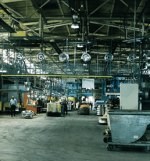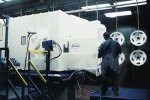From Vision to Reality
Family businesses are typical in the finishing industry. Family businesses that double in size in a few years are not...
More than 70% of family businesses do not make it through the second generation according to Industry Week magazine. And of those businesses that do survive, only 10% remain after the third generation. These statistics do not appear accurate for the finishing industry, since many family owned and operated finishing companies survive. However, they do have their "ups and downs." Areway, Inc., Brooklyn, Ohio, knows all about it.
Areway, a family-owned and operated company founded in 1967 by Sidor and Agrio Hadgis, has survived for more than 30 years and thrived under second-generation ownership. Until 1994, daily operations at this polishing/buffing/plating shop were run primarily by family members (not unlike most familyowned shops) and President Gregg Hadgis recognized the value in a more diversified management group. That year, Gregg, who was also serving as president of NAMF, changed the management style at Areway to synchronize it with the quickly growing company. Gregg's decision paid off, and in four years the company has experienced dramatic growth in worth, profit and size.
Although Gregg and his brother John had no written development plan, they always knew where they wanted to go in the industry. Most changes flowed witheconomy. "In the recession of the early nineties,"said Gregg, "we had to take some roundabout ways, but we knew where we were headed." The brothers have taken the company from vision to reality.
Together with John, Gregg developed management teams for the two business units, decorative finishing and wheel finishing. The company that opened in 1967 as a small decorative polishing and buffing shop now offered automated high-volume polishing and buffing, liquid and powder coating and plating.
Ralph Gillies manages Division One where the roots of the company run deep. Here, Areway runs the decorative product line with skilled polishers and buffers and operates three nickelchromium rack-plating lines. Automation is not a possibility with some complex parts. However, the artisans running the polishing and buffing lathes are masters. "They could put their signatures on some pieces," Lou Virost, Division Two Business Unit Manager complimented. One customer's part at Division One requires 32 manual steps for the first polish, obviously not a candidate for automation.
"We have customers today that started with us when the shop opened," explained Mr. Gillies. "Some of these jobs would be easier to pass on to other shops, because we do not make money on them. But these people helped us get where we are today, so we will always take care of them."
This steady business has helped Areway expand and improve its facilities as well. In 1998, the company added a state-of-the-art nickel-chromium plating line at Division One. This line is capable of preparing product for PVD processing. Areway currently plates for the plumbing, nautical and automotive industries.
To improve its wheel finishing ability and satisfy customers, Areway develops partnerships with its customers. These alliances begin in the design stage, with the wheel manufacturing companies and automotive manufacturers. "Our intent is to make wheels that require as little labor to finish as possible," stated Lou Virost. "We first quote a job on the manual labor involved. Then we determine whether or not automation can handle it."
Areway tries to automate as much as possible; however, much of the product today requires more labor intensive finishing than years ago. Five years ago wheel polishing and buffing was simplistic to automate, but people are no longer interested in plain looking wheels. The trend leaned toward brighter and brighter wheels with complex designs. This, in turn, forced more labor-intensive finishing.
"We have managed to use robotics wherever possible," noted Mr. Virost. "We cannot eliminate all of the manual labor." Automation is crucial to consistency. John Hadgis built or rebuilt most of the polishing and buffing equipment at Areway. The company also designed and developed its own control systems for the polishers and buffers. One cannot simply put a wheel on the spindle and assume a perfect finish each time.
"You have to consider the processing method for each wheel. Whether it is a forged wheel, stamped and fabricated or cast. Areway can polish aluminum wheels manufactured using all the different methods. Some companies' raw wheels work better than other companies' raw wheels. There is a delicate balance between creating something attractive, sellable and polishable," explained Gregg. "We take wheels and make them represent chrome without the excessive cost. Another reason polished wheels are beneficial is that unlike steel chrome, these wheels are recyclable. With the cost competitive nature of the OEM's, polished wheels can be very attractive."
In order to make wheels more polishable, Areway is often called in on the designing process. "We get to see the future," noted Gregg. "We are quoting on jobs for the year 2000/2001." One humorous example of Areway's involvement was a wheel program that had a series of bullets circling the wheel. John told the designers if they removed the bullets, polishing and buffing would be much easier, more consistent and hence less expensive. "They told John that he could change anything but that," quipped Gregg. Therefore, John developed a technology to finish the wheels.
Keeping up with the wheel business required several commitments from Areway. One is the Detroit-area office established in 1997 that provides Areway a closer connection to automotive and wheel manufacturers.
The other project Areway committed to was installing a new powder coating system. The oneofakind system is of such a caliber that it has been benchmarked for other systems in the industry. With the addition of powder coating, the company offers polishing, buffing, plating, liquid coating, powder coating and accredited testing in one stop.
The powder coat-ing line was the most extensive improvement and addition to the company. Areway in- stalled the fully automated powder coating line in 1994. Powder coating commenced in 1995. Here, wheels ranging from 14 to 24-1/2 inches are powder coated clear or with a tinted powder. The coating system has been recognized for producing wheels with superior filiform corrosion performance.
The system boasts a 14 stage stainless steel washer for pretreating the wheels. The chemistry is supplied by Henkel Surface Technologies and features a nonchrome conversion coating.
Powder is applied in a climate-controlled booth contained in an atmospherically controlled room. The Nordson system applies two mils of powder or greater. Areway uses Ferro's clear and tinted powder coatings. One advantage is that Ferro is based in Cleveland; therefore, shipping time from manufacturer to Areway is minimal.
A fivezone oven cures the powder coating. Three infrared ovens bring the parts up to temperature assuring proper cure. Two convection ovens are used for final curing.
In addition to preproduction runs, the accredited lab is capable of conducting all tests necessary to meet the automotive durability requirements and specifications.
Areway is also working on QS 9000 certification, although it is a Tier II supplier to the automotive industry and has no steadfast requirements to achieve this certification. Gregg Hadgis sees this as an opportunity to improve the company.
Everything Gregg and John do, every plan they implement, every dollar they spend is to improve the company. They had no written plan for Areway, but they did have vision. "You are not always going to be successful. But if you don't keep striving, you are not going to be successful at all," noted Gregg.
Related Content
An Overview of Electroless Nickel Plating
By definition, electroless plating is metal deposition by a controlled chemical reaction.
Read MoreProducts Finishing Reveals 2024 Qualifying Top Shops
PF reveals the qualifying shops in its annual Top Shops Benchmarking Survey — a program designed to offer shops insights into their overall performance in the industry.
Read MoreNanotechnology Start-up Develops Gold Plating Replacement
Ag-Nano System LLC introduces a new method of electroplating based on golden silver nanoparticles aimed at replacing gold plating used in electrical circuits.
Read MoreTroubleshooting Alkaline Zinc
One of the most common problems that can arise when plating with alkaline zinc is an imbalance of brightener in the solution. In this helpful Ask the Expert article, Chad Murphy of Columbia Chemical discusses how different zinc metal concentrations and brightener concentrations can impact efficiency.
Read MoreRead Next
Education Bringing Cleaning to Machining
Debuting new speakers and cleaning technology content during this half-day workshop co-located with IMTS 2024.
Read MoreEpisode 45: An Interview with Chandler Mancuso, MacDermid Envio Solutions
Chandler Mancuso, technical director with MacDermid Envio discusses updating your wastewater treatment system and implementing materials recycling solutions to increase efficiencies, control costs and reduce environmental impact.
Read MoreDelivering Increased Benefits to Greenhouse Films
Baystar's Borstar technology is helping customers deliver better, more reliable production methods to greenhouse agriculture.
Read More

























